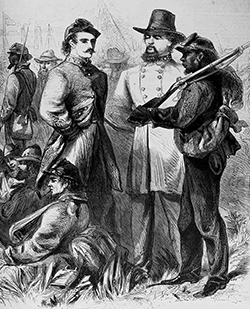
Please send all Checks and Money orders to :
Dave Taylor P.O. Box 87 Sylvania, OH 43560
419-842-1863
Click Here to E-mail Us!


13 09
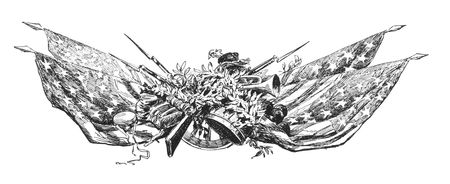

13-09-01 … Beautiful 1840 Pattern Heavy Cavalry Saber by Horstmann.
This is the pattern adopted by the US army for the dragoon regiments in 1840 and used by the US mounted forces right up through the Civil War alongside the somewhat lighter pattern 1860 saber. Horstmann was perhaps the best known military goods supplier during the period and sold large numbers of these sabers by private sale and also to arm state and federal troops when US manufacturing could not keep up with demand. This saber is absolutely beautiful. Perfect three branch guard with undisturbed light age patina, near perfect plum brown scabbard, smooth and pretty with no dents or damage, and an extra fine blade with no edge nicks, good luster, strong markings, and some of the original cross-polishing marks near the ricasso still visible. When found the leather grip material was badly deteriorated so I had it professionally restored at a cost of nearly two hundred dollars. The restoration is PERFECT and if I didnt tell you I had it done you would never doubt it was original. This also still has the leather washer at the blade shoulder near the guard that was meant to seal the scabbard when sheathed. An extremely nice example of this weapon, many cuts above most others we find, and a key piece in a Civil War collection. Damn fine saber
… $750.00 SOLD
Click Here to E-mail Us!
Call us @ 419-842-1863
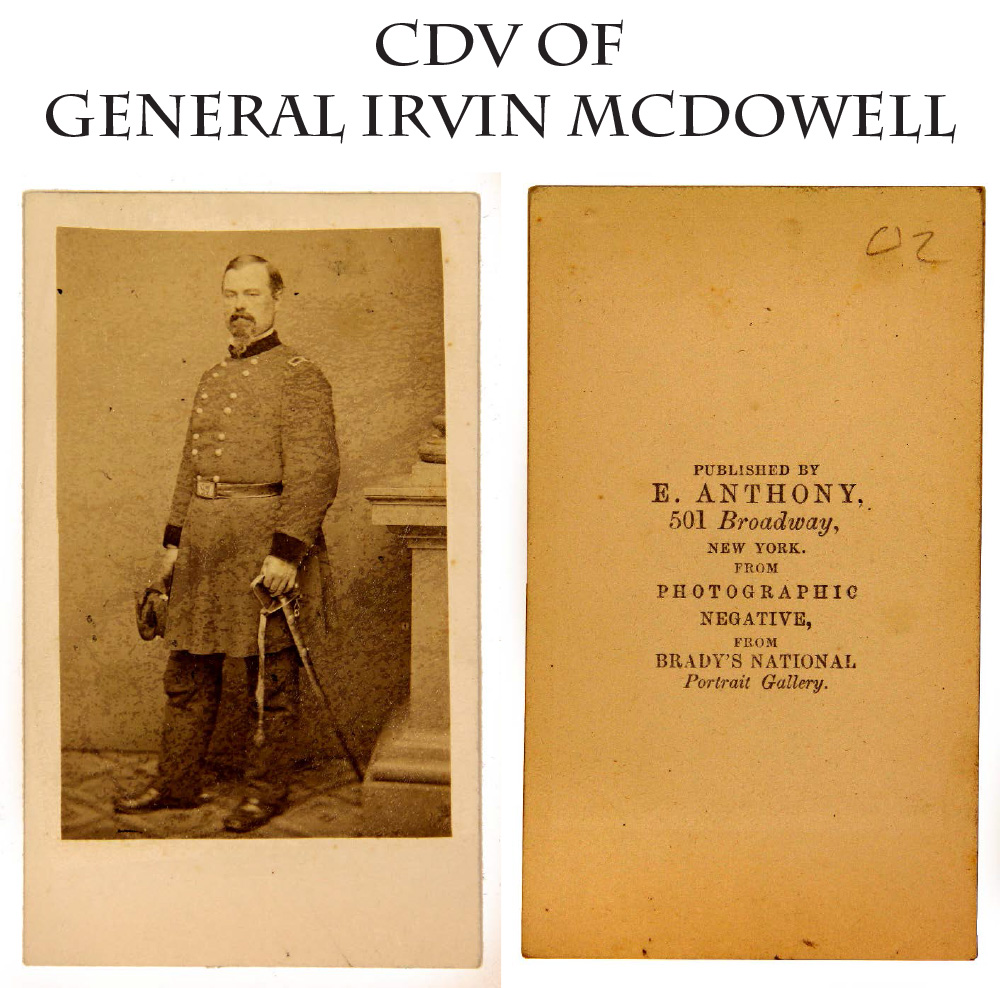
13-09-02 … CDV From-Life – Brigadier General Irvin McDowell …
Good full-standing view of the famous, but ill-starred, general. E. Anthony New York backmark made from the Matthew Brady negative that was part of his National Portrait Gallery. McDowell wears a brigadier generals frock coat and straps, a rank he gained in May, 1861, holding his trademark cap down at his side and holding the hilt of a saber hanging from his belt. (The sword looks Austrian, and Austrian goods were all the craze at the time.) He was West Point Class of 1838 and served on Wools staff in the Mexican War. Forever tied to the defeat at First Bull Run, he is perhaps more famous for the extra tall forage cap he wore which collectors still refer to as a McDowell Pattern Cap. Later he was in command of the Department of the Pacific. He made major general in the regular army in 1872, and retired in 1882. Ironically, he taught tactics at West Point in the early 1840s, likely to some future high-ranking Confederate officers
… $95.00
Click Here to E-mail Us!
Call us @ 419-842-1863

13-09-03 … Quarter Plate Outdoor Civil War Camp Scene Tintype – Twelve Billy Yanks and their Dog.
Such outdoor hard images are most unusual and very, very, scarce. Eight men seated and four standing, wearing a variety of military suits, some in fatigue blouses, many in shirt sleeves and suspenders, most wearing forage caps. Tent is a large wall tent with a fly over the top. These all seem to be enlisted men. The seated figure on the far right has a wide stripe on his trouser leg and is thus likely a sergeant. There is some rust on the left but totally stable. Same with some surface crazing. Outdoor camp tintypes seldom turn up in any condition, and the subject matter here more than makes up for a little roughness in condition. These soldiers are the typical fighting men of the army relaxing for a brief period in camp before facing a new campaign and whatever fate may have in store for them. Best part about it is of course — Fido, or Spot, or Harvey, — the regimental mascot …. I always love a dog. The stories of canine regimental mascots serving in battle can fill a book, and in fact have. Get yourself a copy of Charles Worman’s
Civil War Animal Heroes.
You can add this image to it as an addendum. Just the tintype no frame or case.
… $450.00 SOLD
Click Here to E-mail Us!
Call us @ 419-842-1863
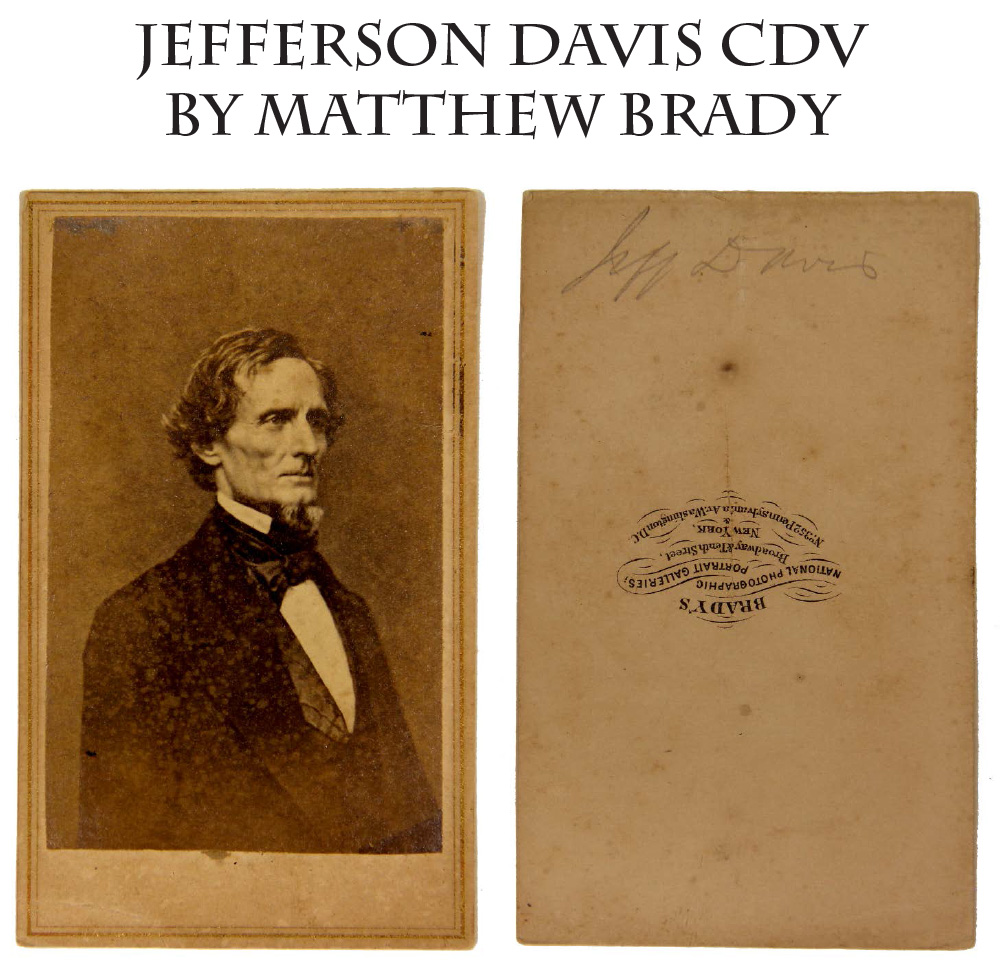
13-09-04 … Jefferson Davis CDV … Superb waist-up portrait of Confederate President in formal frock, vest, high collar and black bowtie.
Needless to say, a key figure in the war and events leading up to the crisis! Brady National Photographic Portrait Galleries backmark. No tax stamp, so an early to mid-war card. Excellent tones and clarity, some mottling shows on the coat, but this is in the negative not the print. West Point Class of 1828, resigned but later Colonel of the Mississippi Rifles in the Mexican War. He returned from the war, gained a senate seat, appointment as Secretary of War under Pierce, and another term in the Senate during Buchanans administration. Heavily involved in secession, slavery, and states rights debates before the war. His record as Confederate President was hotly debated and he was overshadowed in southern affections by Lee after the war, but reestablished a reputation by the time of his death in 1889. Typical of the images of the era bought for placement in family photo albums that mixed family members and friends with sentimental scenes and important personages. A solid image and much clearer than most we find
… $195.00 SOLD
Click Here to E-mail Us!
Call us @ 419-842-1863

13-09-05 … Lamson, Goodnow and Yale Special Model 1861 Rifle Musket.
These Special Model 1861 rifle-muskets were very similar to the 1863 Springfields and were produced only by Colt, Lamson Goodnow & Yale, and Amoskeag. The hammer configuration is the most obvious change like a 63 style, and the use of split barrel bands without springs are likewise as on the 63 Springfields. The lock is clearly marked US over L.G.&Y. over Windsor Vt. forward of the hammer and 1863 to the rear. Eagle on bolster. Barrel has clear VP/eagle proofs on left barrel flat and clear 1864 date on top of barrel near breach indicating assembly in early 1864 using a lock plate made at the end of 1863 (one year differences in date stampings are totally acceptabled, a plate made in December 1863, can be assembled with a barrel made in January 1864 unlike a two year spread in dates where Lucy might have some splainin to do. Wood rates vg+ with no chips, dings or splits, just some rounding of edges from handling and use. Cartouches are still visible on the offside. Very slight shrinkage at edge of buttplate tang. These were finished in the bright and the smooth metal retains a lot of it below some surface brown spots. 100% proper with correct second type rear sight, original front sight firmly in place, correct barrel bands, swivels, and correct ramrod. Lockplate and hammer show signs of case color that has shifted toward a smoky hue. Mechanically perfect, VG bore. This is a nice midwar gun in very good condition and a variant
… $1,550.00
Click Here to E-mail Us!
Call us @ 419-842-1863

13-09-06 … Pistol Cartridge Box with US Plate …
Cavalrymen and others issued with a revolver required a separate cartridge box for its ammunition, which was issued in small paper packets or paper covered wood blocks holding six rounds and percussion caps. The leather cartridge boxes show up in three sizes which correspond to the changes in design for the ammunition packs. The interior of the box uses not a cartridge tin, but a set of friction leathers to keep the packs in place until the soldier is ready to draw and open them. Unlike previous theories, the size of the leather cartridge box had nothing to do with the caliber of the ammunition: they fit .44 and .36 cartridges equally well. This is nice early to mid-war example of the mid-size box using rivets on the belt loops, but just a simple straight line of stitching on the latch tab. Box is solid. Some scuffing and minor finish loss on the edges and flex points, but good overall. The soldier added a rare small size M1839 US oval cartridge box plate to the front flap, a non-regulation touch that shows up in some period photos and improves the displayability about 300%. A nice piece to augment that cavalry display. It would look great on a saber belt, or laying next to a revolver. Top notch example in all respects
… $450.00 SOLD
Click Here to E-mail Us!
Call us @ 419-842-1863

13-09-07 … Fresh from an auction in southern Ohio is this Identified Sergeants Pipe from a Hard-fighting Regiment.
Few things are more emblematic of Civil War camp life than the soldiers smoking pipe. In off-duty hours in tent and camp hut tobacco was in near universal use, pipes were everywhere and were part of just about every officer and enlistedmans effects. Here is a very nice example not just of a period pipe, but one with a legitimate personal identification carved into the bowl by the soldier or a talented tentmate. Three inch burl wood bowl has a nice warm brown patina worn smooth by handling. As usual the pipe stem is missing. Signs of charring are clearly inside the bowl from actual use. Carved neatly in block letters on the front face of the bowl in two lines is:
SERGT. A. U. HALL
1 VT. ART.
Albert U. Hall (1834-1912) resided in Londonderry, Vt., and enlisted 7/29/62 as a Sergeant and mustered into Co. G of the 1st Vt. Heavy Artillery on 9/1/62. He was reduced to Corporal on 12/4/64 and then promoted to Sergeant again 2/11/65. I am sure there is a story in there somewhere but I will let you dig it out. He mustered out 6/24/65.
Initially recruited as an infantry regiment, the Eleventh Vermont Volunteers, it quickly was changed and enlarged to a heavy artillery unit, and assigned to the forts in the defensive ring around Washington. Company G, Halls company, was assigned to Fort Lincoln and then to Fort Slocum. Along with a number of other such regiments the unit was called to the front for Grants 1864 overland campaign and put into service as infantry. The regiment was so large that its three battalions served independently under Majors in the Old Vermont Brigade of the Sixth Corps, and took part in some of the bloodiest fighting of the war at Spotsylvania, Cold Harbor, Petersburg, Weldon Railroad, Opequan, Cedar Creek, etc. In the course of this service 10 officers and 154 enlistedmen of the regiment were killed in action or mortally wounded, as well as wounded and recovered a large butchers bill for any unit. This pipe has a lot going for it in several arenas perfect for a Vermont collector, or as part of a camp display, or for those seeking identified personal items carried by soldiers in the war. A darn fine personal item
… $695.00 SOLD
Click Here to E-mail Us!
Call us @ 419-842-1863
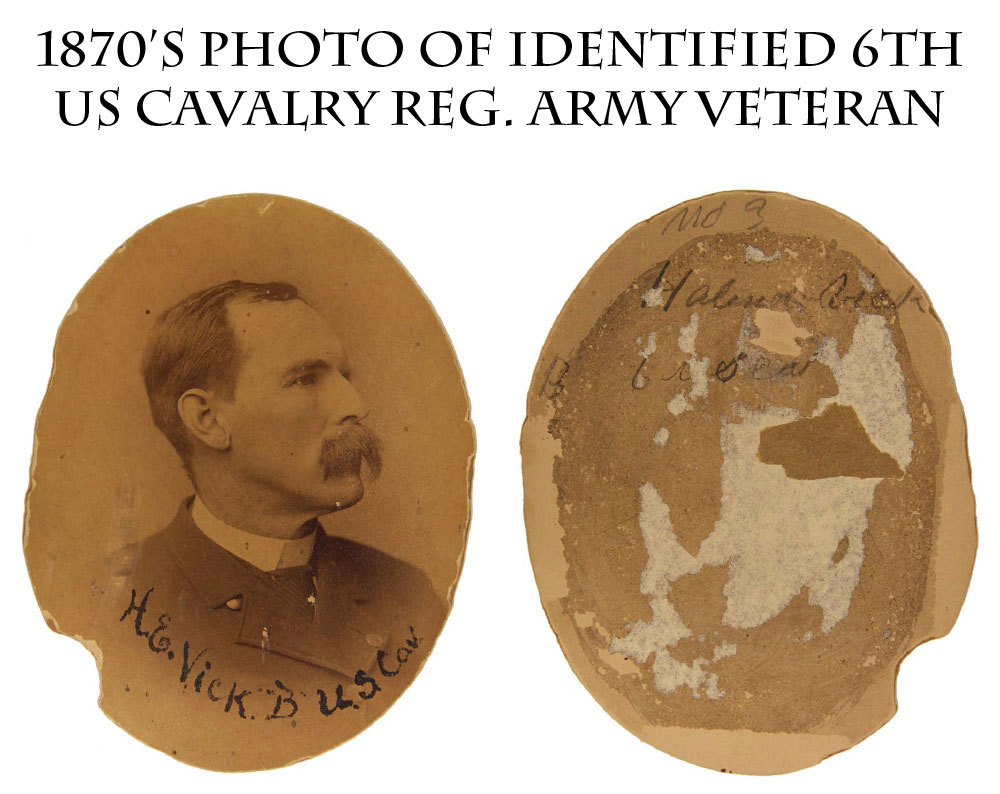
13-09-08 … GAR Photo Identified 6th US Cavalry Trooper:
The Sixth US Cavalry was an interesting unit and there is a regimental history just recently released. Recruited in May, 1861, in Pennsylvania and Ohio, the regiment was a new addition to the US army and was originally designated the Third US Cavalry. When all mounted units were redesignated cavalry in August the Third changed its numerical designation to the Sixth. It was mounted and equipped in Maryland in September, though only two companies were issued carbines until early 1862, the regiment being considered light cavalry until then, most companies armed only with pistols and sabers. It then took the field and saw its first fighting with McClellan during the Peninsular Campaign that Spring.
Here is a photo of one of their veterans, wearing a GAR coat by the look of it, with a GAR lapel stud as well, taken about 1890. Obviously removed from a frame at some point. Irregularly trimmed along edge and some edge chipping, glue spots on reverse, but not affecting image itself and would look great matted again. Identified along lower edge in period ink: H.E. Vick B U.S. Cav. and on reverse No. 3 / Holend Vick/ B 6 US Cav. in ink and pencil. Holland E. Vick enlisted as a private in Co. B of the 6th US Cavalry on August 5, 1861. He was discharged for disability Oct. 18, 1862, at Fortress Monroe, but this would have given him service during the Peninsular Campaign and through Antietam. A cursory online search shows a Holland Vick born in Ohio in 1834, and this may be our man, though the regiment also supposedly had a large number of recent Irish immigrants in it. It had a good wartime record though, and many of its officers were transfers from other regular army units when it was first organized
… $79.00
Click Here to E-mail Us!
Call us @ 419-842-1863

13-09-09 … Exceedingly Rare Confederate Imprint!
Identified to a First Louisiana Cavalry Officer. Regulations for the Army of the Confederate States for the Quartermasters Department, Including the Pay Branch Thereof. Ritchie & Dannavant Printers. Richmond, 1862. Marbled covers, cloth spine. Period ink on outside front cover: A. C. Herndon / AQM/ 1st La. Cavalry. Signed in ink inside: A.C. Herndon A Q M 1st La Cavalry Herndon enlisted as a private in Company C of the 1st Louisiana Cavalry in August, 1861. He was then detailed as regimental Quartermaster Sergeant. By November, 1862, he had been commissioned as Captain and Acting (or Assistant) Quartermaster of the regiment. The regiment had been recruited at Baton Rouge and was assigned to the western department and joined Albert Sydney Johnston at Bowling Green, KY. It fought in more than 75 engagements including Munfordville, Stones River, Chickamauga, Missionary Ridge, and Perryville and served in the brigades of Forrest, Scott, and Pegram. In early 1864 the regiment was ordered back to Louisiana and fought in eastern Louisiana and western Mississippi. During this period Herndon appears on detached duty as paymaster for Gen. Davidsons Cav. Brigade, which was based in Rome, Georgia, in early 1864 and took part in the Atlanta Campaign.
The Confederacy seldom had a problem with the fighting ability of its forces. Keeping them supplied was quite another problem. Of some note is the presence of a manuscript receipt written across This is a scarce the last page which reads … Received at Liberty in the state of Mississippi this 5th day of November 1862 of A.C. Herndon Capt. & AQM C.S.A. the sum of Forty Thousand Dollars on account … Really cool personalized CS imprint dealing with a crucially important aspect of the Confederate army and a darn rare book in and of itself
… $650.00 SOLD
Click Here to E-mail Us!
Call us @ 419-842-1863

13-09-10 …
By Discipline and Bayonets!
British late 18th – early 19th century Brown Bess Bayonet. Stats 18-5/8” overall. 14-3/8” blade. 3-9/16” socket. .848” inner diameter. Redcoats charging with fixed bayonets scattered many an opposing force. Our own militia in the Revolution often suddenly remembered better things to do back home than stand and face an oncoming line fringed with blades like this. Nice condition, silvery gray overall mixed with some darker areas. Just very light salt and peppering on the shank. Markings include an inspector numeral “4” on the face, along with “K&A” (Ketland and Allport … Allport was dead by 1817). Also marked “1A.” K&A supplied several contracts. This blade I believe is for a third model Bess supplied on the commercial market- I don’t see a crown marking. There are quite a number of variants of this bayonet and it forms a collecting subgroup of its own.
This one is real nice with the early maker’s marks.
… $250.00
Click Here to E-mail Us!
Call us @ 419-842-1863

13-09-11 … Nice full standing view in double breasted field officers frock with straps,
one hand on hip, the other holding a tall McDowell style cap down at his side. Table next to him with another cap on it. E. & H.T. Anthony / Matthew Brady N.Y. backmark. Period pencil id at bottom card front: Col. Fletcher Webster and on reverse: F. Webster. Websters full name was Daniel Fletcher Webster, born in 1818, son of politician and statesman Daniel Webster. He served as Secretary of Legation for the embassy sent to China in 1842 and as Chief Clerk of the State Department, an influential post. When war broke out he was a customs house officer living in Marshfield, Ma. He enlisted and was commissioned as Colonel of the 12th Massachusetts on 6/26/61. The regiment was raised largely by his effort and was named the Webster Regiment in his honor. Even the regimental color bore a famous Webster motto of the time: Not a stripe erased or polluted, not a single star obscured. They reached Maryland in late July and were assigned to guard the upper Potomac River between Washington and Frederick, Md., as part of Abercrombies Brigade, Williams Division, Banks 5th Corps. In early 1862 they were moved to the Shenandoah Valley and joined Hartsuffs Brigade, Ricketts Division, McDowells 3rd Corps, Army of Virginia. They suffered casualties at Balls Bluff, Winchester, Gaines Mill, and Cedar Mountain, but Second Bull Run was their first major engagement. Heavily engaged on August 30, 1862, near the Chinn House on Bald Hill, they lost Webster mortally wounded and 25 others killed outright or mortally wounded, in addition to those who were wounded and recovered, captured, or missing. Webster had trained the men well and they went on to maintain a distinguished fighting record at Antietam, Fredericksburg, Chancellorsville, Gettysburg, Wilderness, Spottsylvania, Cold Harbor and Petersburg as part of the 1st and the 5th Corps.Webster was highly regarded. The regimental history of the 11th PA actually mentions him thus: Among the losses in the brigade, outside of our regiment, none was more keenly felt than the death of Col. Fletcher Webster of the Twelfth Massachusetts. Our first introduction at Falmouth, in the preceding month of May, had grown into an intimacy still remembered with pleasure. The colonel was a brave and chivalrous soldier, partaking largely of the arm impulses and noble nature of his illustrious father.
On the Battlefield of Second Bull Run a memorial was placed in his honor:
In memory of Colonel Fletcher Webster Who here fell August 30, 1862 while gallantly leading his regiment the 12th Mass. Volunteers
This memorial was dedicated Oct. 21, 1914 by survivors of his regiment and Fletcher Webster Post, G.A.R. of Brockton, Mass.
He gave his life for the principles laid down by his father Daniel Webster
“Liberty and union, now and forever, one and inseparable” This boulder was taken from the Webster place, Marshfield, Mass.
A scarce wartime, from-life, photo of a true battle hero who was killed at the head of his regiment. Truly historical
… $295.00 SOLD
Click Here to E-mail Us!
Call us @ 419-842-1863

13-09-12 … 1812 Era British Flintlock Military Pistol:
8.5 inch barrel 14 inches overall. Large bore of about .70. The wonderful Lion mark on the lock is the marking of the World Famed British East India Company — a conglomerate of private business investors and mercenaries with full military authority and the support of Mother England herself.
To fight off European rivals and subdue locals who were unable to appreciate the benefits of British empire, the Company actually had its own armies and ordnance supply networks. British military men often took posts in the Company’s regiments when the British army was inactive, and they were sometimes the only ones with any real field experience when war broke out. The “lion passant,” walking and holding a crown was the Company mark starting in 1810 and it is prominently stamped on the lockplate, with a “C” over a “2” next to it. The checkered wrist seems to me to elevate the gun a notch or two and make it more an officer’s pistol of the type that might make its way back into regular army use by an officer who had served with the Company or acquired his weapons from Company suppliers, but Company weapons are a specialized collector’s field. Reinforced hammer, front blade sight. pinned barrel, two lock screws without side plate, a few very minor dings in the wood opposite the lock, brass triggerguard. Wood ramrod an old replacement. Rounded butt. Good condition, functioning, and a nice looking flint pistol. I like the variety that flint pistols offer for the collector. The mechanisms are interesting and they are the last of the individually artisan produced weapons before the age of mass production, interchangeable parts, and assembly lines. Overall VG condition save for the eyelet for accepting the securing pin is broken off on the bottom of the barrel. Unless you disassemble it you can’t see it. Nice old Flintlock for 1812 or Napoleonic display
… $1,150.00 SOLD
Click Here to E-mail Us!
Call us @ 419-842-1863
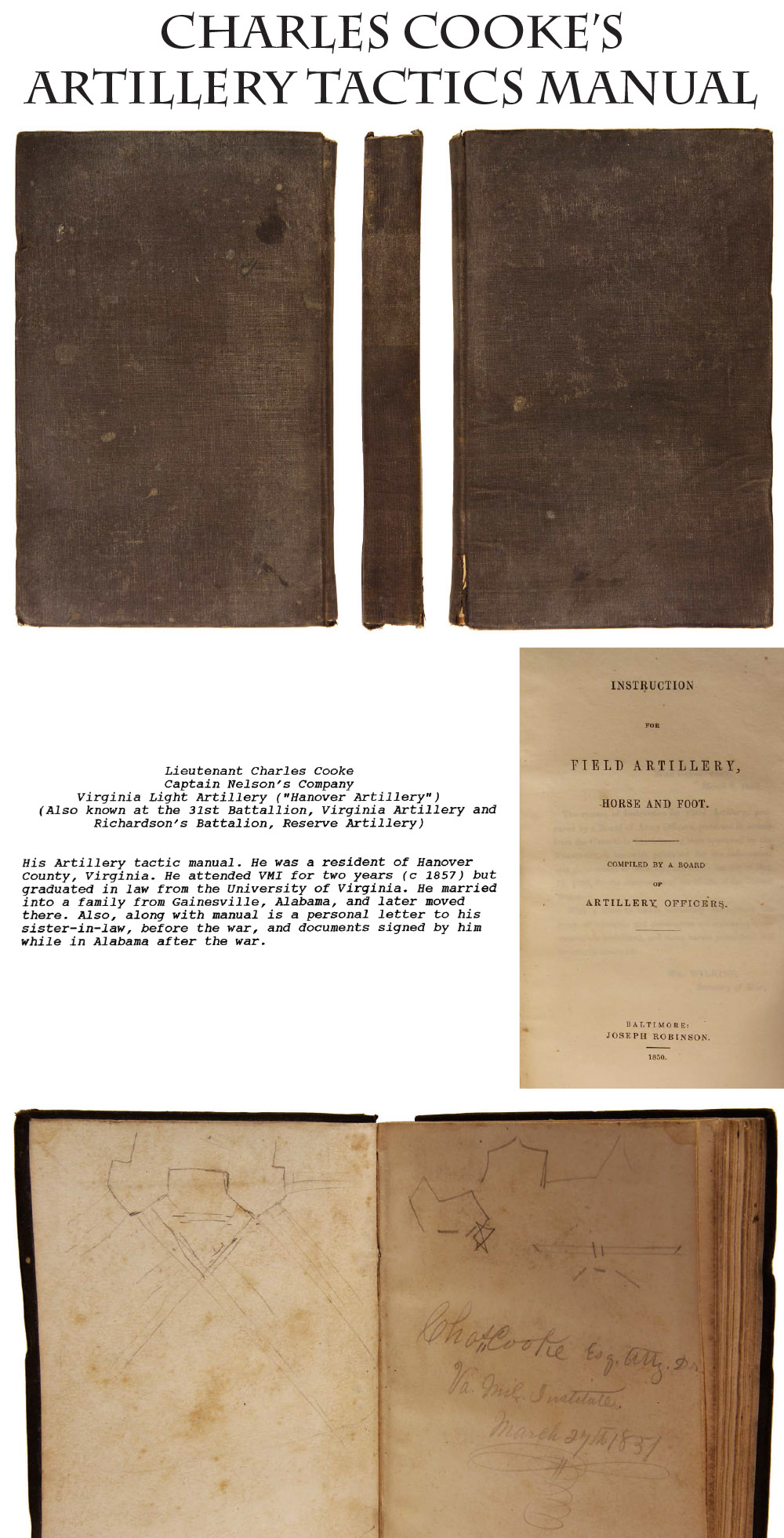
13-09-13 … RARE RARE RARE – Artillery Tactics Manual Belonging to Charles Cooke, Hanover Artillery, CSA …
Instruction for field artillery, horse and foot. Compiled by a board of Artillery Officers. Baltimore: Joseph Robinson, 1850. A pre-war US artillery manual with a good Confederate association. Inscribed in period pencil: Chas. Cooke Esq. Atty. Dr. / Va. Mil. Institute / March 27th 1851. Period pencil sketches by Cooke inside the endpaper and on the flyleaf of fortifications and angles of fire. Cooke was a resident of Hanover County, Va., and enrolled in VMI in 1848 and graduated in the class of 1851 and then became a lawyer. When war broke out he joined Captain Nelsons company of Virginia Light Artillery, known as the Hanover Artillery, (and as the 31st Va. Artillery, and Richardsons Artillery. He enlisted as a First Lieutenant and in May, 1861, signed a roll as commanding the company. The battery served in the Peninsular Campaign was disbanded in the army reorganization of Oct. 1862 and most men transferred to Capt. Kirkpatrick and Capt. Woolfolks companies, and in Nelsons and Richardsons Battalions Reserve Artillery. He apparently returned to the practice of law and died in Ashland, Va., in 1908. One heck of a rare book all by itself and infinitely more important with the Confederate inscriptions. You would be hard pressed to find ANY Field Artillery manual on the market – much less a Confederate and VMI used example
… $750.00 SOLD
Click Here to E-mail Us!
Call us @ 419-842-1863

13-09-14 … CDV Photo Officers of an Indian Wars Black US Infantry Regiment.
Six officers and the sutler of the 38th US Infantry, later the 24th US Infantry, circa 1866. Very appealing and candid outdoor tent scene of six officers and the sutler, apparently included by mistake! One of the regular army black regiments, the 38th US was organized in July, 1866, and in service under that designation until March, 1869, when it was consolidated with the 41st US Infantry and was redesignated the 24th US Infantry. As was the case with all the black regiments, the officers were white and most had seen Civil War service in other outfits, often with brevets in the regular army for gallant or meritorious service in the war. This is a group of strong characters by the look of them. Several sport the regimental insignia on the front of their caps. They are numbered on the face of the card in small red numerals which are keyed on the back:
1.)
a Surgeon Forward
—William Henry Forward, Asst. Surgeon, 8/61; Major, Surgeon. 6/76; Lieut. Colonel 6/91; Brig General, Surgeon General 6/02; retired 9/02; Bvt. Captain and Major (3/65) for “faithful and meritorious service.”
2.)
Capt.
(illegible).
3.)
Bvt. Lt. Col. Conyngham
—John B. Conyngham, 2nd Lieut., 8th Pa. Inf. 4/61; Major, 52nd Pa. Inf. 11/61; Lieut. Colonel 1/64; Colonel 6/65; m/o 7/65. Captain 38th US Inf. 3/67; 24th Inf. 11/69. Bvt. Major for Yorktown (3/7/67); Bvt. Lieut. Colonel for Fair Oaks (3/7/67); died in service 5/71. 4.)
Sutler (my mistake)
. Apparently the writer of the identifications may have invited the men to sit for the photo and regretted including the regimental sutler with them!
5.)
Lt. Gardner
—William F. Gardner, 2nd Lieut., 118th Pa. Inf. 9/62; 1st Lieut., 11/62; m/o 6/65. 2nd Lieut. 38th US Inf. 3/67; transferred to 24th US Inf. 11/69; died in service 9/72.
6.)
Lt. Thompson
—John Milton Thompson, 2nd Lieut. 33rd USCT, 1/63; Captain 11/63; m/o 1/66. 2nd Lieut., 38th US Inf. 7/66; 1st Lieut. 11.67; transferred to 24th US Inf. 11/69; Captain 12/78; Major 4/98; Colonel, 42nd USV Regt. 8/99; Lieut. Colonel 14th US Inf. 10.99; Colonel 23rd Inf. 4/01; Bvt. 1st Lieut. (3/2/67) for James Island, SC; still in service 1902.
7.)
Capt. Ezekiel
—David Israel Ezekiel, 2nd Lieut., 10th WV Inf. 9/62; m/o 9/65. Captain 6th USV 4/65; m/o 10/66. 1st Lieut., 38th US. Inf. 7/66; 4th US Inf. 4/70; retired 6/78. Bvt. Captain (3/2/67) for Harpers Ferry; died 3/95.
Far rarer than Civil War CDV photos… a real piece of Indian War photo history
… $395.00
Click Here to E-mail Us!
Call us @ 419-842-1863

13-09-15 … Rare Military Book: Mexican War Manual With Confederate Use, and a Relic of Friends Parted by the War!
A treatise on Field Fortifications by D.H. Mahan, Wiley & Putnam, 1846. Cloth bound.
Identified in three places in period pencil by a Confederate officer: “Maj. Thos. K. Jackson / Chief Army of / Miss/ State of Ala. County/ of Sumter Town of / Gainesville” and twice more with his name and rank, as “Maj. & CS.” Thomas Klugh Jackson was West Point Class of 1848 and served in the regular army until April 1, 1861, when he resigned and joined Confederacy as a Captain in the 1st South Carolina. He was appointed Acting Quartermaster, Acting Commissary of Subsistence, and Ordnance Officer and assigned to Lynchburg, Va., site of an arsenal, and assigned to Gen. Wise’s command. From there he was assigned to report to Gen. McCulloch in Arkansas and then Gen. A.S. Johnston, where he was appointed Chief Commissary and eventually promoted Major and Chief Commissary of the Western Department. He was then assigned to Gen. Buckner’s staff and was captured in the surrender of Fort Donelson. Imprisoned briefly at Fort Warren, he was apparently exchanged, for he returned to duty at Gainesville, Alabama, by August, 1862, and was appointed Depot and then District Commissary, and was noted as being in charge of government cattle. He seems still to have been performing this duty when Gen. Taylor surrendered forces west of the Mississippi in May, 1865, and he was paroled.
One other name appears in pencil with no rank or unit, and there are a couple of blurred ink inscriptions that may be earlier owners. Interestingly, one of them may be named Dodge and be the original owner for the date “Novr. 1847,” appears in the same hand as does the notation “Co. I 8 Reg.” The first owner may have been Richard Irving Dodge, who was in the same class as Jackson at West Point, and served with him in the 8th US Infantry from graduation until 1861, when they parted ways. Dodge was from North Carolina, but remained loyal and received promotions to Captain and Major, as well as brevets to Lieutenant Colonel and Colonel, and ending up as Aide-de-Camp to Sherman after the war.
Needless to say, we can’t tell the exact nature of the relationship between Jackson and Dodge, if that is in fact his name in the book, but they did spend four years at West Point together and another twelve in the same regiment, so there may be something of a story yet to be brought out. In any case, this is a very nicely inscribed manual showing Confederate use
… $750.00 SOLD
Click Here to E-mail Us!
Call us @ 419-842-1863

13-09-16 … Rocket Brigade Photo!!!
He Gave Himself Up to the Belief that He Should Never Return Home Alive. This card is a mix of comedy and tragedy, coming from an extremely rare and unusual unit: Battery B, New York Rocket Battalion, a two-company battalion commanded by an ex-British officer named Lions, who claimed to have experience with rockets and to have developed a special pattern. Period pencil id, probably in the soldiers own hand: Corp. C R Griffith Rocket Battalion Camp Congreve Washington D.C. Feb 3rd 1862. Full-standing view of soldier in uniform resting his right arm on a column, holding his forage cap by the brim which gives a clear view of the company letter B on top. In his left hand he grasps the hilt of his saber, a cavalry pattern, which is sheathed. He has thrust a small pocket pistol through his saber belt to augment the warlike pose. He wears a mounted jacket with shoulder scales, and the jacket is the scarce NY state issue pattern for mounted troops, having a belt loop on one side fastened at the top by a button.
The name of the camp is appropriate for a rocket battalion: Congreve was the inventor of British military rockets (think of the Rockets red glare as they fired them at us in the War of 1812.) The unit mustered in late 1861 and served in Washington until April, 1862, when it was assigned to the District of North Carolina and to the 18th Corps. This unigt actually saw action firing rockets. In March that they received four, four-tube rocket guns mounted on carriages. One veteran recalled: We took them over to the east branch of the Potomac to try them; we expected to see wonders (as we had been told that, with a little practice, a flagstaff could be hit five miles off). An artillery blanket was hung up for a target, about three-fourths of a mile distant. While we were shooting at it, some cold-blooded scamp stole the blanket. The rockets were balky; like a mule, they would go any way but the right way. That night rocket stock was low in camp. The next day they were returned to the armory, and we received three inch rifled guns. As for Major Lions, the battery historian remarked, In the minds of those best acquainted with him, I find there were doubts as to whether he knew anything at all about the science of gunnery or of this projectile. The two companies were redesignated the 23rd and 24th Independent Batteries in late 1862. Charles R. Griffith enlisted at age 22 in Perry, NY, on 10/1/61 as a Corporal and mustered into Battery B, the NY Rocket Battalion, on 12/7/61. Griffith made sergeant 11/4/62 and reenlisted 1/1/64 as a veteran. The battery was engaged in numerous expeditions in the New Berne area, and in actions such as Kinston, Whitehall, and Goldsboro. Unfortunately they were at Plymouth in April, 1864, and were involved in the siege and subsequent surrender of the that town. Griffith was captured 4/20/64 when the place surrendered, was interned as a POW at Florence, SC, and died there 12/31/64, though the battery history lists him as a victim of Andersonville. The battery history says: He seemed to have little hope after his capture, and gave himself up to the belief that he should never return home alive. An Albert Griffith, also from Perry, NY, served in the battery as well and may have been a brother. He too died in prison. A very unusual card with an interesting history and probably loads more information to be dug out. In the 45 years I have collected Civil War antiques this is the first rocket battalion relic I recall owning
… $350.00 SOLD
Click Here to E-mail Us!
Call us @ 419-842-1863
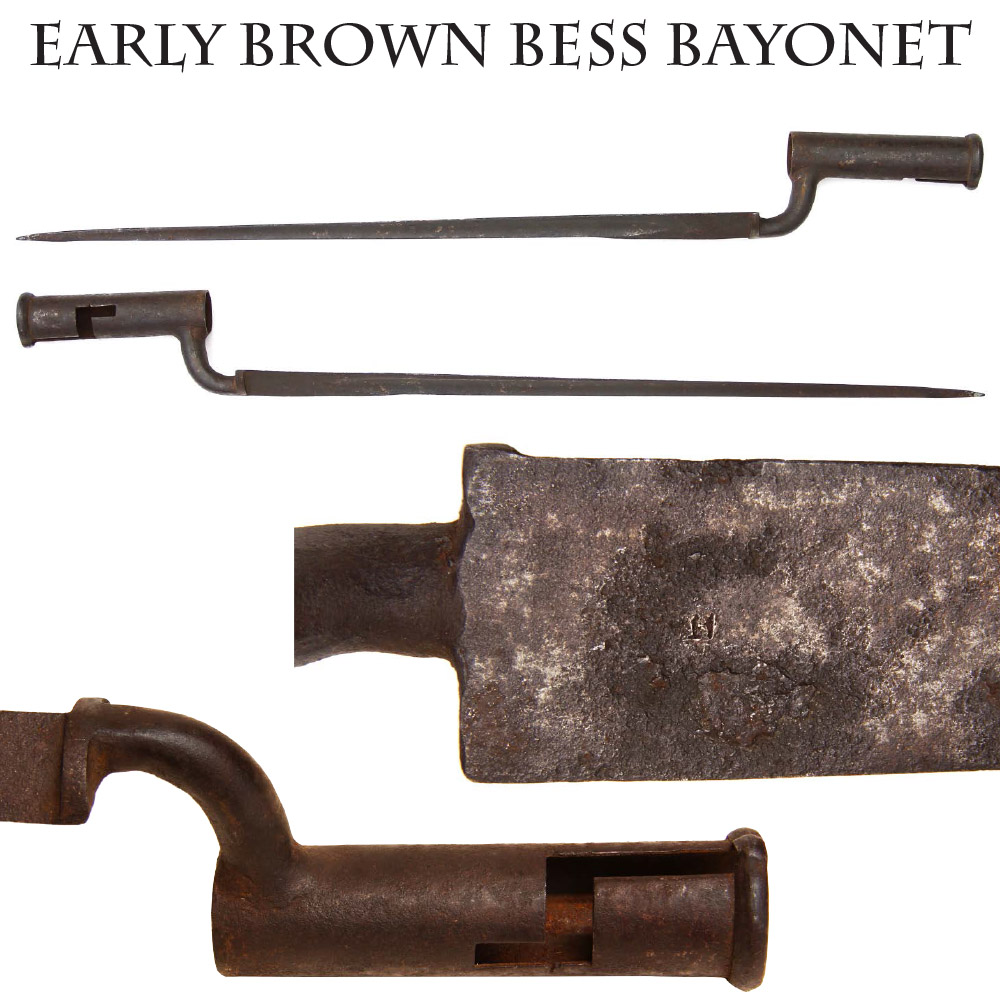
13-09-17 … Early Brown Bess Bayonet:
Good condition bayonet for the British Brown Bess musket. Socket measures 4-1/8 … ; blade 16-15/16 … interior diameter of socket .910. Brown rust patina overall, uniform and honest. … no edge chips, etc. Small numeral or makers mark (maybe an H) near the shank, no other marks. Likely for a third model Bess or a period fusil. As with the example offered above, these present a lot of variation for the collector and a lot of history for the money
… $235.00 SOLD
Click Here to E-mail Us!
Call us @ 419-842-1863
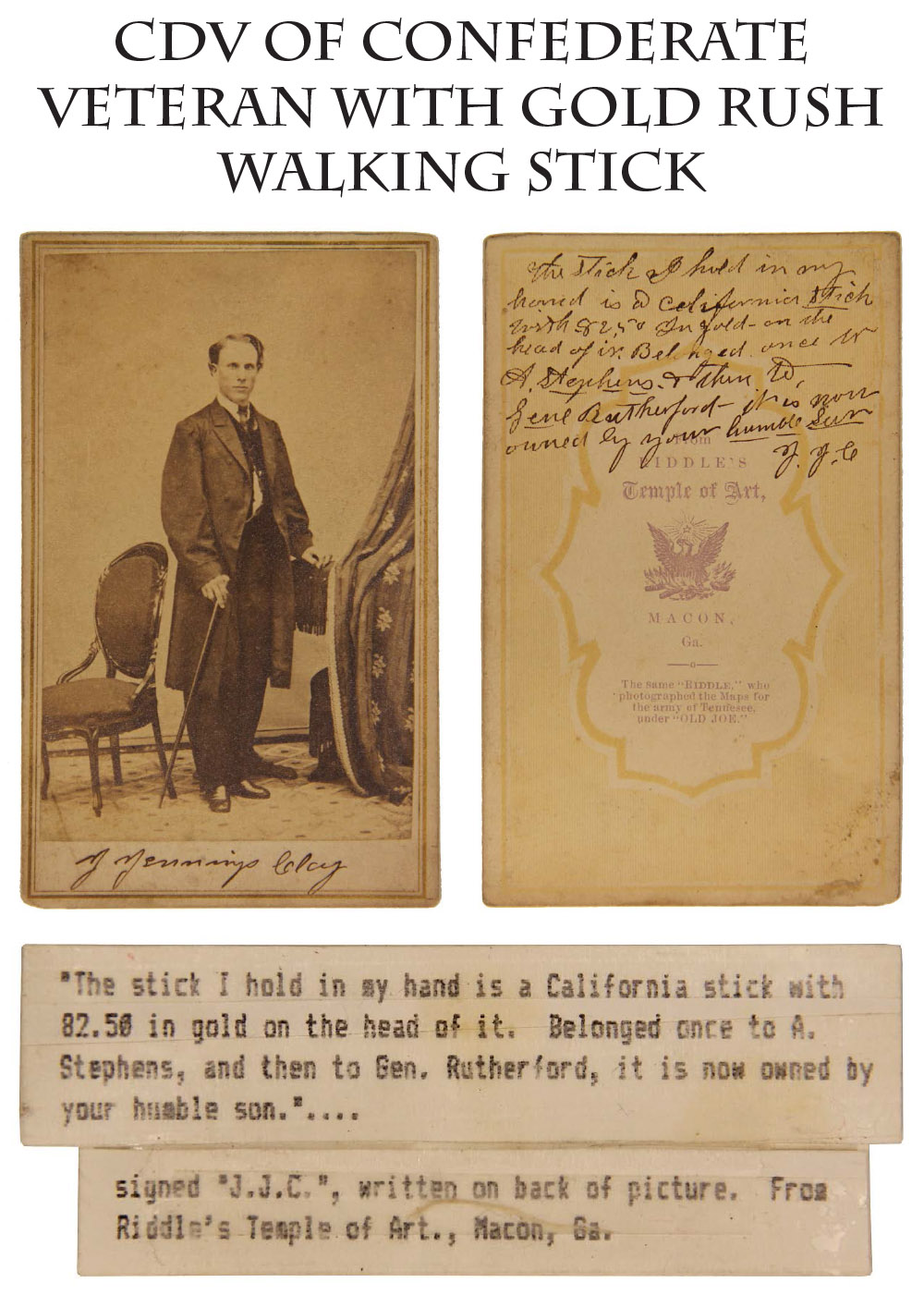
13-09-18 … Incredible CDV of Confederate Veteran with Gold Rush Walking Stick.
How often do we get a stereo presentation of Gold Rush 49’er history in concert with the Confederacy? Full-standing studio pose of a formally dressed young man standing next to a chair, with his hand on the back of another partially concealed by a drape. In the other hand an elaborate walking stick, tip on the floor, head visible above his fingers. Signed bottom edge: “J. Jennings Clay” On reverse: Riddle’s Temple of Art, Macon, Ga., backmark (“The same ‘Riddle’ who photographed the maps for the army of Tennessee under ‘Old Joe.’” In period ink at top reverse: “The stick I hold in my hand is a California stick with 82.50 in gold on the head of it. Belonged once to A. Stephens & then to Genl. Rutherford- it is now owned by your humble Servt. J.J.C.”
“J. Jennings Clay” is listed in the Confederate service records. He enlisted as a private in Co. H 1st Mississippi Cavalry. The company served as Co. A 1st (Miller’s) Battalion Mississippi Cavalry and then was transferred to the 1st Miss. Cavalry in June, 1862. He is listed as “present” until August, 1863, when he is marked “absent sick on surgeon’s certificate Aug. 1, 1863.” He was marked as detailed to Macon, Ga., in January, 1864, but again marked as present May to Oct. 1864, when he was transferred as “unfit” for field service. It is possible the transfer actually took place in January, but was not recorded on company records till then. In any case, he was reported captured at Macon, GA. 4/20 or 4/21/65 by the 1st Brigade, 2nd Cavalry Division.
The identity of “Genl. Rutherford” is uncertain, but being a Georgia card, “A. Stephens” is certainly Georgia politician Alexander Stephens (1812-1883,) US Congressman, Vice President of the Confederate States and Governor of Georgia. Mr. Clay must have done very well for himself after the war to acquire such a trophy containing such a large amount of California Gold. He was certainly proud enough to show it off and not bashful about its monetary value either! As interesting a civilian view as I have offered recently
… $450.00
Click Here to E-mail Us!
Call us @ 419-842-1863
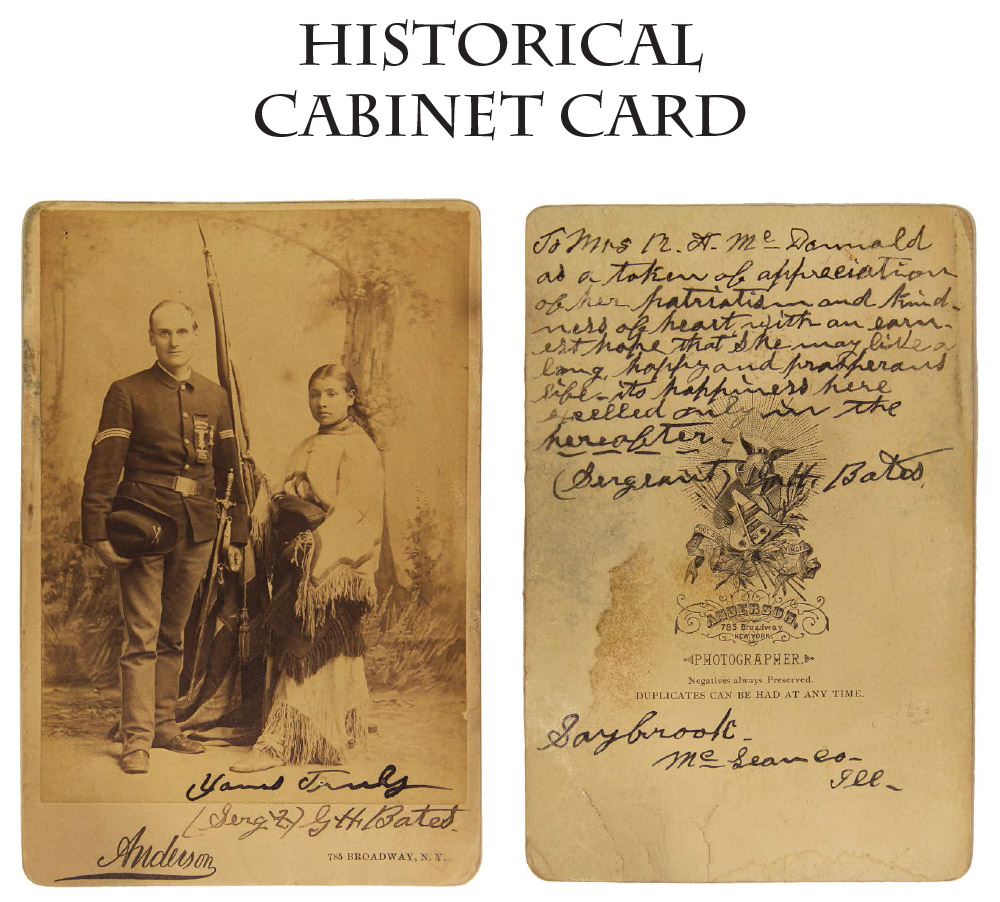
13-09-19 … Incredible Photo – Sergt. Bates Cabinet Card:
Sergeant G.H. Bates, The American Standard Bearer and Sioux Princess Julie Nelson. A very striking Cabinet Card photo by Anderson of New York of two nineteenth century celebrities and members of Buffalo Bills Wild West Show. At left is Sergeant Gilbert H. Bates wearing an Indian War period five-button sack coat with sergeants chevrons, a GAR medal and ribbon on his chest, an 1874 pattern waistbelt, a slouch hat with cavalry insignia on the front, and what appears to be a medical staff sword at his side. Next to him stands Julie Nelson, a member of the Oglala Sioux tribe, who also performed in Codys show as a Sioux Princess. She poses in full regalia of fringed dress, moccasins, etc., holding the staff of a furled US flag slightly behind Bates. Signed lower front, top line at bottom of image: Yours Truly / (Sergt.) GH Bates
On reverse, Anderson, NY backmark, and a lengthy dedication by Bates: To Mrs. M.A. McDonald as a token of appreciation of her patriotism and kindness of heart with an earnest hope that she may live a long happy and prosperous life, its happiness here excelled only in the hereafter. (Sergeant) G.H. Bates / Saybrook McLean Co. Ill. Gilbert H. Bates (1836-1917) enlisted as a sergeant in the First Wisconsin Heavy Artillery in Bristol Wisconsin on 9/17/64 and mustered into Company H the same day. The company served in the defenses of Washington as part of the 4th Brigade, De Russeys Division, 22nd Army Corps. Bates served until mustered out on 6/26/65 and returned to Wisconsin. He later recounted that in late 1867 he and a neighbor disagreed about whether southerners had truly reconciled themselves to returning to the Union and Bates decided to demonstrate their loyalty by walking from Vicksburg through the southern states all the way to Washington, carrying a US flag, going unarmed and without money, vowing also to sell photos of himself for 25 cents along the way to raise money for widows and orphans of both sides. The walk covered some 1,400 miles and was extensively covered by the press. Mark Twain thought it was a bit of self-promotion that would end with Bates spending the money he took in on a champagne blow-out, or with him getting to Washington minus a leg, an arm, an eye, and his scalp. Bates, however proved Twain wrong. He was treated hospitably along the way, ended up unfurling the flag in Washington and being greeted by President Andrew Johnson. He soon after published a booklet on his walk and went on an extended speaking tour. Fortunately, William F. Cody picked him up in 1886 to appear in his Wild West Show as a sort of novelty or variety act. One (perhaps somewhat cynical) author wrote that he had made such a nuisance of himself tramping about the country- particularly the former CS states- carrying a flag and giving patriotic lectures, that Cody received praise for getting him off the public roads. A really top shelf piece of Civil War, Reconstruction, Wild West photography with immense eye appeal
… $450.00 SOLD
Click Here to E-mail Us!
Call us @ 419-842-1863

13-09-20 … Sword – With Buford at Gettysburg (pending verification): A Michigander in the 8th New York Cavalry —
They delayed the Confederates on the Cashtown Pike! High Grade Gettysburg-Carried Presentation Staff and Field Sword that just surfaced and I have just sent for the archives data. The swords owner, Alfred C. Wortley served in three different regiments from three different states: the 6th Michigan, the 2nd Maryland Infantry, and finally the 8th New York Cavalry in time for Beverly Ford and Gettysburg.
Eaglehead quillon US 1850 Staff and Field Sword by Sheble and Fisher of Philadelphia and so etched on the ricasso. Typical Iron Proof etching on the back edge near the hilt. Typical Field and Staff configuration of the gilt brass guard with an artistic US worked into the floral design. Good original wrap and twisted brass wire. Nice patina to brass with original gilt remaining in the recesses. Quillon terminates in nice eagles head poking down at the blade. Regulation blued iron scabbard with brass mounts showing no dents or bends, but good field use in the rubbing of the blue, giving it a faint sky blue/light gray appearance with some brown rising here and there. Mounts are nicely decorated with scalloped edges and floral motifs on the central raised ring mount bands, and floral motifs engraved in the upper portion of the drag. Blade is light gray overall with darker gray areas, but with legible etching: makers name at ricasso, floral and mixed geometric motifs, U.S. on one side, eagle on the other. Definitely a sword carried in the field by an active officer, and the regulation sword for a Regimental Adjutant. On the upper mount in beautiful mixed script and block lettering is engraved: Presented to Lieut. A.C. Wortley by the/ Officers of the 6th Regt. Mich. Inftry 1861 This man was fun to research. Alfred C. Wortley enlisted in Kalamazoo, Michigan, at age 21 on 8/20/61 and mustered into the Field and Staff of the 6th Michigan Infantry as the Quartermaster Sergeant the same day. As such, he was a key figure in the day-to-day running of the regiment, and would have been on intimate terms with the officers. He must have done well because he was discharged 12/14/61 for promotion to First Lieutenant and Adjutant of the 2nd Maryland Infantry, also known as the Second Eastern Shore Maryland Infantry, and was given this sword on that occasion by his Michigan superiors. Both regiments had been posted in Baltimore and the 2nd Maryland was mustered in on Dec. 28, 1861. The date of presentation on the sword thus makes it clear the officers under whom Wortley had served in the 6th Michigan gave him this sword as a token of esteem upon his promotion. The 1850 Field and Staff sword was intended for mounted officers and was the regulation sword for an Adjutant, who served mounted on the regimental staff. The regiment was on duty along the eastern shore of Maryland and Virginia, in the City of Baltimore and on the lower Potomac, where Federal troops were involved in frequent expeditions early in the war to seize arms and break up potential secessionist threats.
But Wortley was anxious for more active service and was willing to take a tiny step down in rank to get there. He mustered out of the 2nd MD on Sept. 3, 1862, and thirteen days later mustered into the 8th New York Cavalry as 2nd Lieutenant of Company G. He certainly got what he was looking for. The 8th New York, known as the Rochester Regiment, was commanded by Benjamin F. Davis, West Point Class of 1854, Alabama born and appointed from Mississippi, who remained loyal to the Union. Known as both a proud tyrannical devil, and our best cavalry officer, Davis had just led his regiment and the 12th Illinois out of the trap at Harpers Ferry before it surrendered, managing to capture a Confederate ordnance wagon train along the way and bring it into Union lines. Davis was given command of the brigade command and a promotion in the regular army. Soon after Wortley joined, the regiment was involved in pursuing Confederates south after Antietam and was engaged in sharp skirmishes at Snickersville, Philomont, Unionville, Upperville, Amissville, and others. Indeed, CWData lists an astonishing 209 occasions when the regiment was engaged or suffered casualties during the war, more than 40 while Wortley was with them. No wonder the scabbard blue shows some rubbing!
Wortley was apparently in the regiment at their two most famous battles. At the largest cavalry battle of the war, Brandy Station, June, 1863, Davis led the First Brigade forward as the lead element of Bufords Division at Beverly Ford. Davis was killed in a personal encounter with a Confederate officer in the fighting and the 8th suffered at least ten killed. Less than a month later, at Gettysburg the regiment was still part of Bufords Division, the brigade being commanded by Gamble. These were the troopers deployed on the morning of July 1 to fight for time along the Cashtown Pike and delay the Confederates of Heths Division until Federal infantry could come up and they fought from roughly 5:00 a.m. till 10:30 a.m., moving from ridge to ridge. Even after Reynolds First Corps arrived they remained on the field and fended off an attempt to flank the Union line. They continued to serve through July 2 and July 3 and then took part in the pursuit of Lees army to Williamsport, which a regimental historian likened to the pursuit after Antietam, except that, the engagements were more frequent and severe.
Lieutenant Wortley served until the end of the Gettysburg campaign, being discharged 7/24/63, and returned to Kalamazoo, Michigan, the starting point for his adventures. An incredibly interesting sword belonging to an officer with a wonderful story! I am simply awaiting delivery of the monthly returns to make sure Lieut. Wortley is listed as present for duty. Assuming so
… $4,750.00 SOLD
Click Here to E-mail Us!
Call us @ 419-842-1863

13-09-21 … CDV Photo Lieut. Col. H.H. Pearson, 6th New Hampshire, Killed in Action at the North Anna.
Nice full standing view of the Lt. Col. in his field officer’s frock with straps, standing bare-headed, hands clasped behind his back, showing off a beautiful high-grade officer’s saber hanging at his side. Ink identified at bottom. On reverse also in period ink: “6th N.H. Vet. Vol. Killed at North Anna River Va. May 26th 1864.” Heard, Boston, photographer backmark and tax stamp. Henry H. Pearson had enlisted at age 22 from Exeter, NH, on 11/27/61 and was commissioned Captain 11/30/61 of Company C. Wounded 8/29/62 at Second Bull Run, he was promoted Lt. Col. 10/5/62.
The regiment spent much of its service under Burnside and part of the 9th Corps. It participated in Burnside’s Coastal Expedition in early 1862 to North Carolina and was involved in various expeditions and fights around Roanoke, Camden, Elizabeth City and New Berne. It was brought up to Virginia again in August, 1862, and fought at Second Bull Run on 8/29/62 which a regimental historian regarded as “the most disastrous to the regiment of any in which it participated, two hundred and ten being killed, wounded or missing out of four hundred and fifty officers and men who went into the fight.”
The regiment covered Pope’s retreat and then participated in the Antietam Campaign, fighting near Burnside’s Bridge. They were again engaged at Fredericksburg, and then followed Burnside out to his new appointment in the Department of the Ohio, and ended up serving with Grant at Vicksburg. The regiment reenlisted as a veteran organization and returned east in 1864 for Grant’s overland campaign, fighting at the Wilderness and Spottsylvania. They pushed forward to the North Anna River and remained in reserve from May 23 to May 25. On May 26, however, they were moved to the front line and Pearson was reported killed by a sharpshooter while reconnoitering the regiment’s position.
The regiment fought the rest of the war in the eastern theatre and was involved in almost daily fighting at Petersburg. Survivors eventually mustered out in July, 1865. During its service the regiment lost 10 officers and 177 enlisted men killed in action or mortally wounded. It was both a hard-marching and hard-fighting regiment and this is a portrait of one of the officers who made them good soldiers. Most historical image
… $275.00 SOLD
Click Here to E-mail Us!
Call us @ 419-842-1863
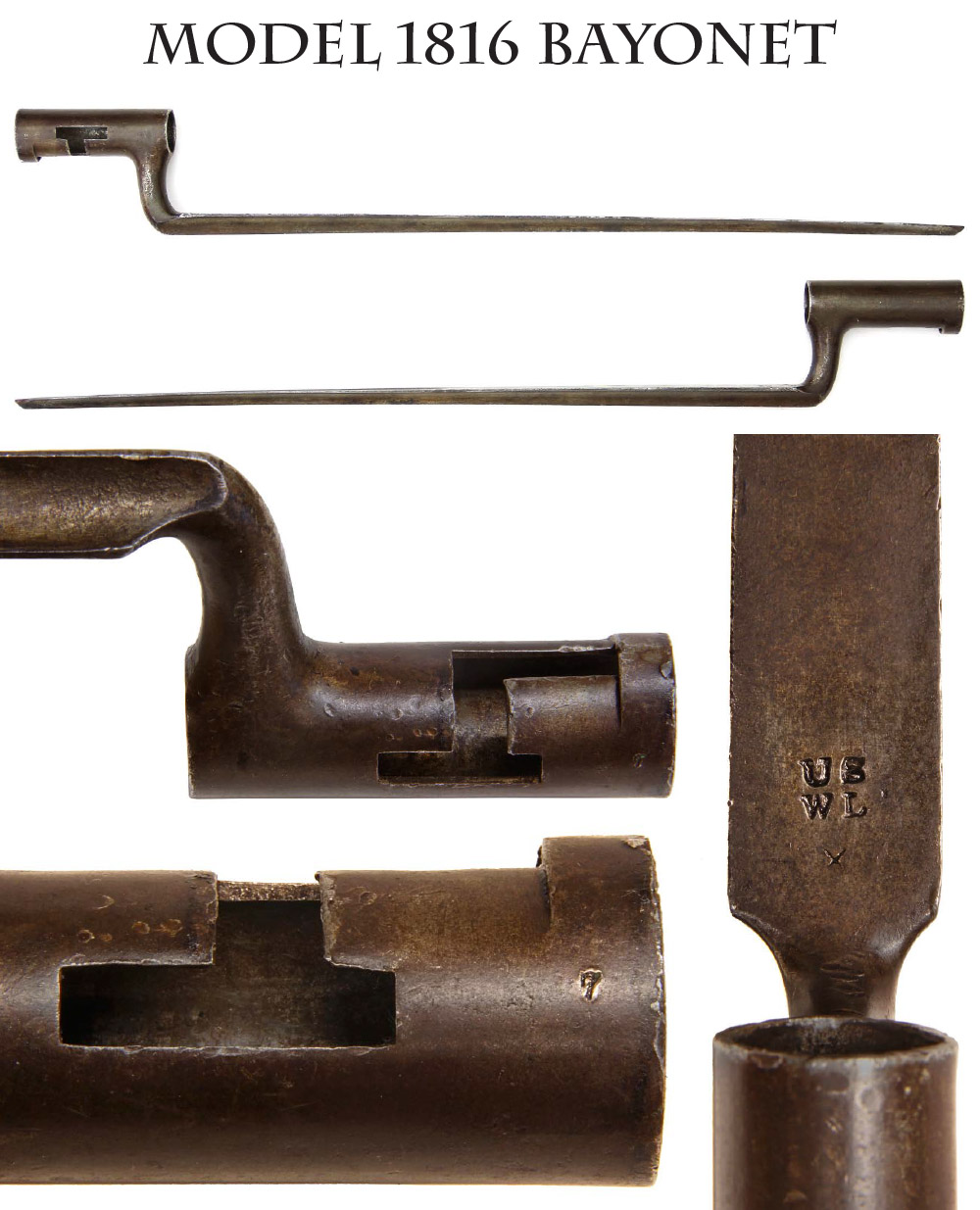
13-09-22 … US Model 1816 Bayonet …
Another key piece for the US bayonet collector. Smooth brown metal overall, US/WL at base of blade near shank, and what looks like a small X, number 7 stamped at mortise slot. Some minor dings at edges. Overall vg. The 1816 is most recognizable by the T-shaped mortise designed to keep the bayonet on the gun even if it moved forward by the recoil of the gun or in bayonet fighting. It was only some years later that designers came up with a suitable locking ring to keep it firmly on the muzzle. A fine solid specimen
… $175.00
Click Here to E-mail Us!
Call us @ 419-842-1863

13-09-23 … Another 1816 Bayonet.
This one just showing a little more age
… $135.00
Click Here to E-mail Us!
Call us @ 419-842-1863
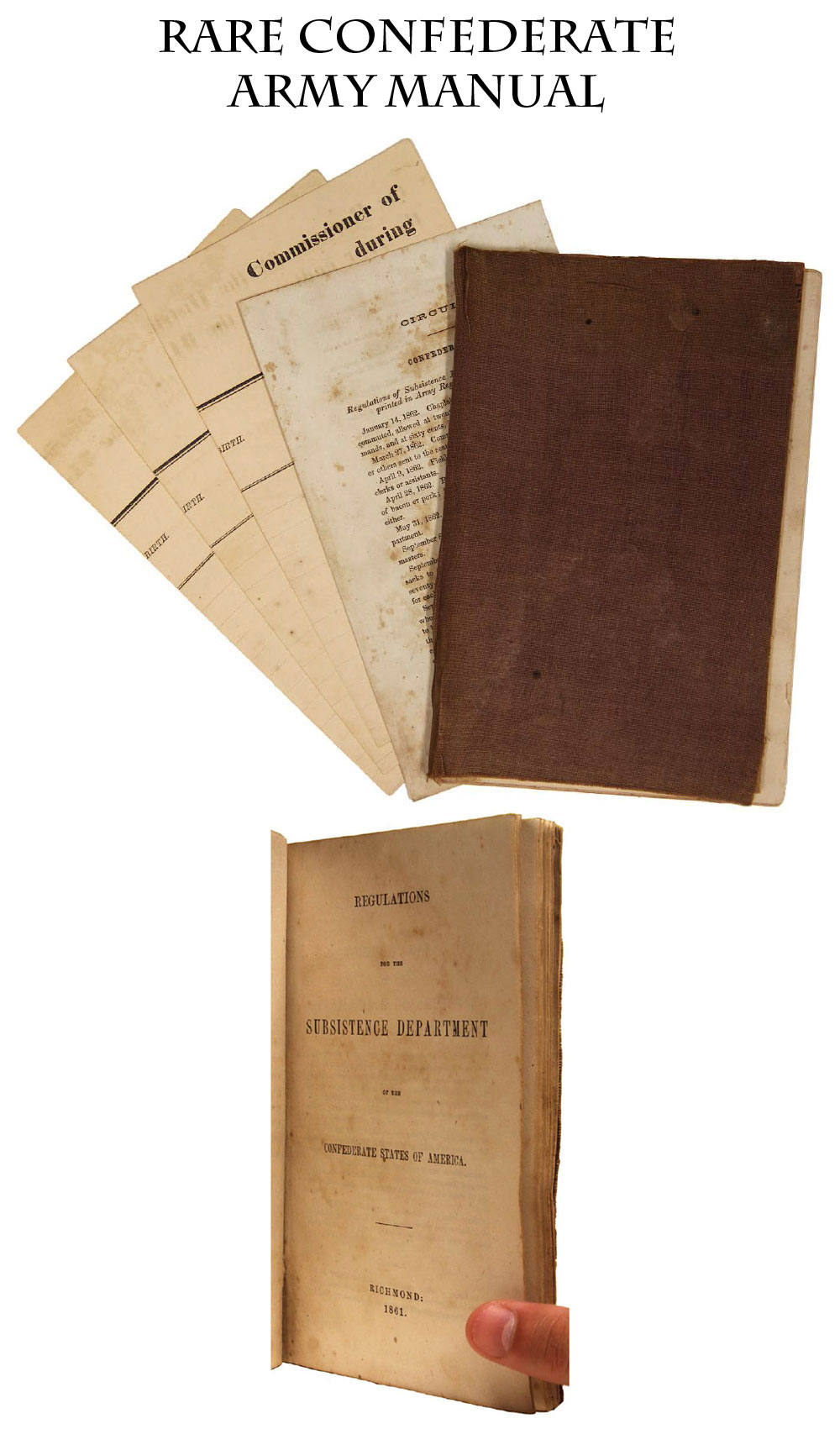
13-09-24 … Rare Confederate Manual Published in Richmond 1861.
Regulations for the Subsistence Department of the Confederate States of America. Richmond: 1861 … Measures roughly 4 x 6 inches across the cover and contains around 75 pages. Cloth edge binding, and covers.
Key manual for the functioning of the Confederate armies during the Civil War. We concentrate on battles and weapons of the war, but they were nothing if the armies could not be supplied, equipped and fed. The Confederacy had to create a working system from nothing and these manuals were key to keeping the nation alive for as long as it lasted. Finding these Rebel manuals printed in Richmond is not a common occurrence these days. The books are getting darn scarce. This from the estate of Major Thos. K. Jackson CSA
… $395.00 SOLD
Click Here to E-mail Us!
Call us @ 419-842-1863

13-09-25 … A classic example of 19th century folk art on the iconic Powder Horn …
This one is very appealing in being of better quality and artistic ability than most of the era. The name “S. Niles” and the date “1865” between leaves are nicely carved in shaded letters. At top an eagle clutching an olive wreath and arrows descends spread-winged with a ribband overhead reading “E PLURIBUS UNUM.” Below this art ducks swim lazily in a pond behind a hunter wearing a short hat who fires his shotgun at a rabbit fleeing through low grass and past a tree, pursued by the hunter’s dog. Above the dog in a ribband, like one of those cartoon thought balloons, is the word “ Time, ” which I suppose might be the dog’s name or possibly is the dog’s way of telling the rabbit its “time is up.” Some very minor insect damage just below and above the hunter’s rifle barrel, otherwise excellent with good base and carved tip. A very picturesque and charming vignette. I don’t know who S. Niles was, but he had good taste in his hunting gear and the quality of this scrimshaw is as good as the classic stuff of a century earlier
… $395.00 SOLD
Click Here to E-mail Us!
Call us @ 419-842-1863

13-09-26 … .41 Cal. Colt “House” or “Jim Fisk” Revolver: Overall VG condition.
100% original and 100% complete… mechanically perfect. A great cowboy era revolver and one of Colt’s more eye catching designs, not to mention packing a darn good punch with the .41 caliber size. Scarce five-shot non-fluted cylinder version with “Pat. Sept. 19, 1871” mark in top strap groove. Only about 2150 of these were made. 2 5/8 inch barrel. “Colt’s House Pistol / Hartford CT. U.S.A.” barrel markings a bit rubbed on the first two words. Birdshead pommel VG. Some little dings to wood and to bottom of pommel on wood and backstrap. Good color overall and nice patina on the brass. Cylinder, barrel and cylinder pin a deep pewter color, slight drag line on cylinder. Serial number 8139. The “Jim Fisk” title among collector’s comes from its use in the killing of “Big Jim Fisk,” also known as “Diamond Jim” in The Grand Central Hotel in New York in 1872. Fisk was a prominent businessman and robber baron whose former business partner took Fisk’s prostitute girlfriend as his own lover and they together tried to blackmail Fisk with stolen business papers his “girlfriend” had purloined from Fisk’s files … which proved illegal business practices. Fisk wasn’t much worried and in effect told both of them to pound sand down a rat whole. The frustrated ex partner couldn’t think of anything else so he dispatched Big Jim with one of these Colts, and was sent to prison for manslaughter.
A good example of a gilded-age and western personal side arm
… $750.00 SOLD
Click Here to E-mail Us!
Call us @ 419-842-1863

13-09-27 …
Extra Fine Colt Lightning Revolver w/ Rare Colt Star on trigger guard showing the gun went back to Colt for repair and refinish during its early life. .41 caliber. Fine++ condition. Totally original and mechanically perfect. The blue and case color finish is Colt factory finish put on while the factory was still producing this model. This is NOT some modern refinish, but is instead a very desirable Colt feature.
If you want to know what a new Colt looked like this is pretty close. This is the Model 1877 Lightning Double Action revolver, .41 Caliber. Serial number 83,711, made prior to Dec. 31, 1898. Colts first attempt at a double action revolver and well liked by westerners. Beautiful factory blue and case-hardening about 99.5%, just the slightest of wear just at the muzzle from holstering and loss of finish on two screw ends (not even the heads, just the tips of the ends!) Patent dates and rampant colt on frame, hard rubber grips with rampant colt, checkering, no chips or cracks. Correct and rare Colt Star stamp on trigger guard shows this gun was sent back to the Colt factory for their refinishing back in the old days. Not sent to some secondary shop, hence the top barrel markings and the Colt DA 41 barrel side marking is just a tad light under the blue. This was obviously a working gun someone cared a great deal for and valued enough to have the Colt factory itself refinish it. The gun was popular and is a great piece for both the Colt and the western collector. Even Billy the Kid carried one, though it did him little good in a dark bedroom against Pat Garrett. All in all, a superior example with infinite eye appeal and a very friendly price
… $1,250.00 SOLD
Click Here to E-mail Us!
Call us @ 419-842-1863
13-09-28 … Rare Confederate Manual Published in Richmond 1861.
Regulations for the Quartermaster Department of the Confederate States of America. Richmond: 1861 Some wear to the faux marbled covers but totally solid. Measures roughly 6 x 4 inches across the cover. 118 pages. From the effects of Major Thomas K. Jackson CSA. Another darn rare book
… $395.00 SOLD
Click Here to E-mail Us!
Call us @ 419-842-1863
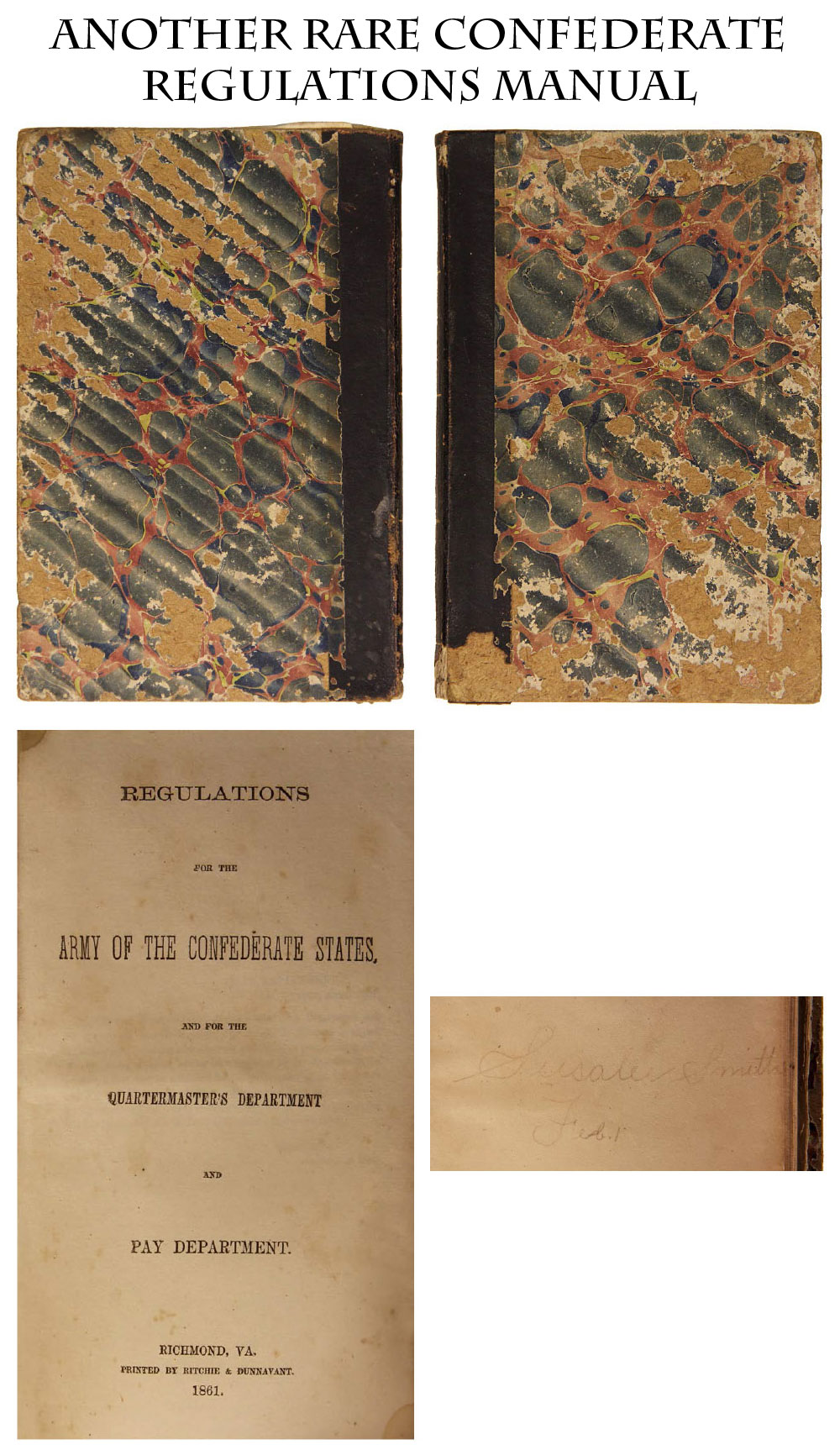

Wonderful Examples of the Die-Sinkers Art!
I am pleased to offer a nice selection of quality powder flasks on this list. You can learn more on the subject in Rilings Powder Flask Book. In 19th century Europe hunting with firearms was largely the privilege of the nobility, whereas Americans all shot game to put food on the table. The Europeans went in for fancy carving and ivory inlays on their arms and flasks. We were satisfied with brass or German Silver inlays and felt fortunate when we could obtain a fine die-struck flask with spring loaded measuring spout. Below are some examples of what we did allow ourselves to indulge in during the mid 19th century.
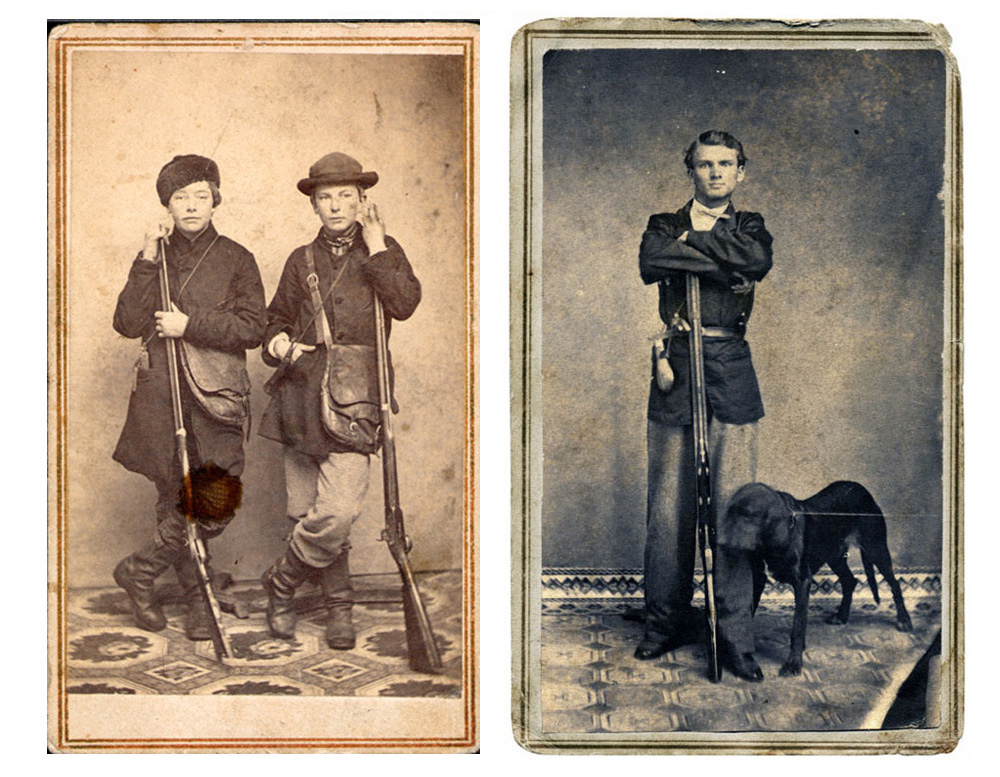

13-09-29 – Leaf Patterned Powder Flask:
Measures 8 1/2 inches long including the spout, and is uniquely decorated with leaf and diamond patterns on both sides of the brass. Neck marked with a “2” as well as an old inventory number “104”. Top of spout dented inwards a bit. Just a few minor scratches visible on body. A fine condition flask overall
… $125.00 SOLD
Click Here to E-mail Us!
Call us @ 419-842-1863
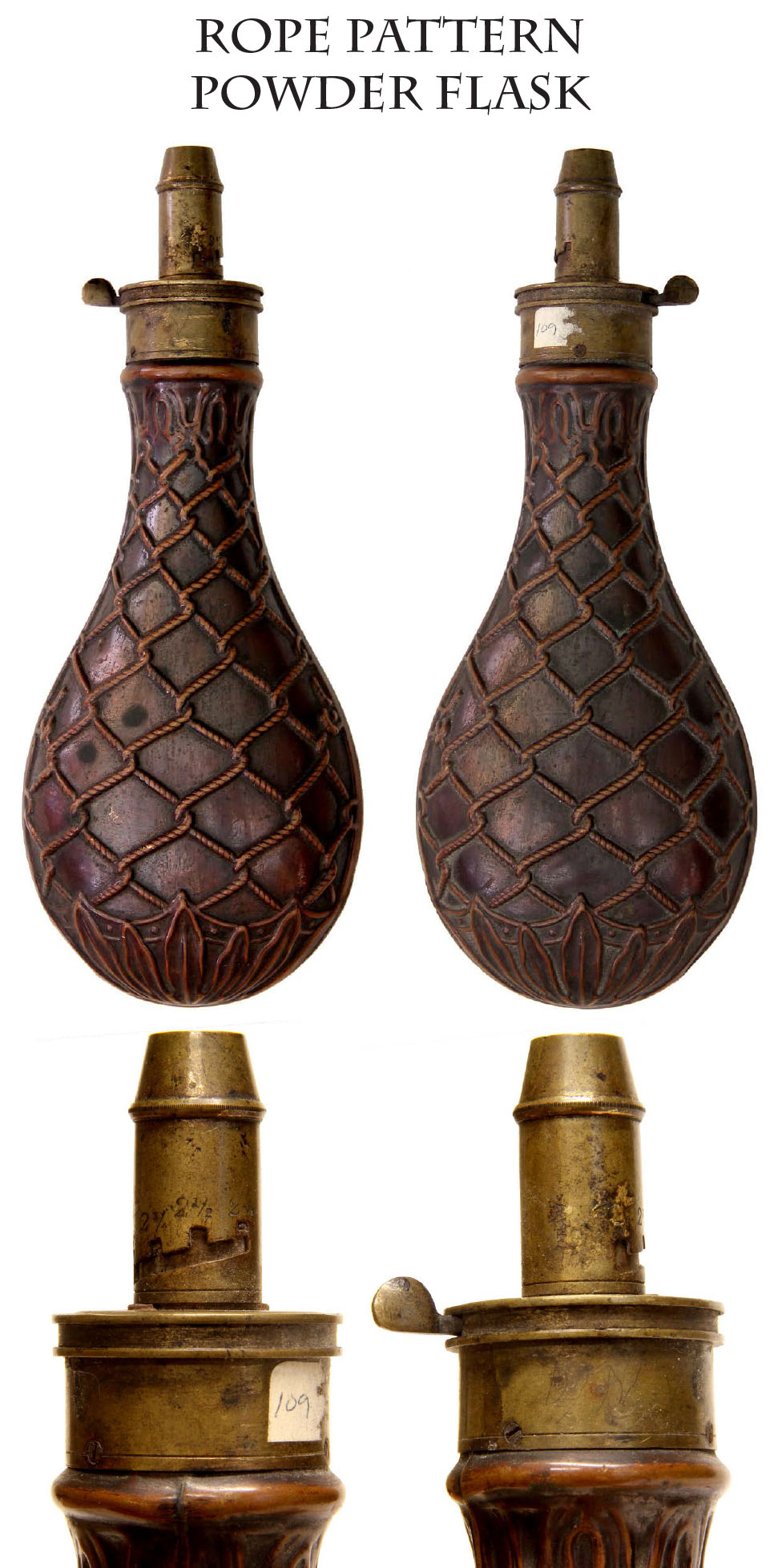
13-09-30 – Rope Patterned Powder Flask:
Measures 8 1/2 inches tall including the spout, and is decorated with a rope pattern on both sides of the copper body. Brass neck still has an old inventory number “109”. The measurer has DRAMS marked to the left of the slots on the spout. Just a small amount of wear and tear on the flask. This rare item would make for a great addition to your collection
… $125.00 SOLD
Click Here to E-mail Us!
Call us @ 419-842-1863

13-09-31 – Decorative Pattern Powder Flask:
Measures 8 1/4 inches long including the spout, and has ornate details on both sides of the body. Base of spout has markings “G & J.W. Hawksley Sheffield” as well as “B.A. & W”. Neck has an old inventory number “52”.
It has some age to it but a fine condition flask overall
… $95.00
Click Here to E-mail Us!
Call us @ 419-842-1863

13-09-32 – Hunting Scene Powder Flask:
Measures 7 1/2 inches long including the spout, and has a detailed hunting scene on both sides of the copper body. Neck has an old inventory number “35”. Has minor dents to body as well as some patina. Overall this makes for a decent condition powder flask
… $95.00
Click Here to E-mail Us!
Call us @ 419-842-1863

13-09-33 – Birds and Leaves Powder Flask:
Measures 8 1/2 inches long including the spout, and has intricate birds and leaves on both sides of the body. On the base of the spout is a marking that reads “G & J.W. Hawksley Sheffield”. Neck has an old inventory number “31”. One side is dented inwards a bit with a minor crack. Aside from that it’s a clean looking flask
… $125.00 SOLD
Click Here to E-mail Us!
Call us @ 419-842-1863
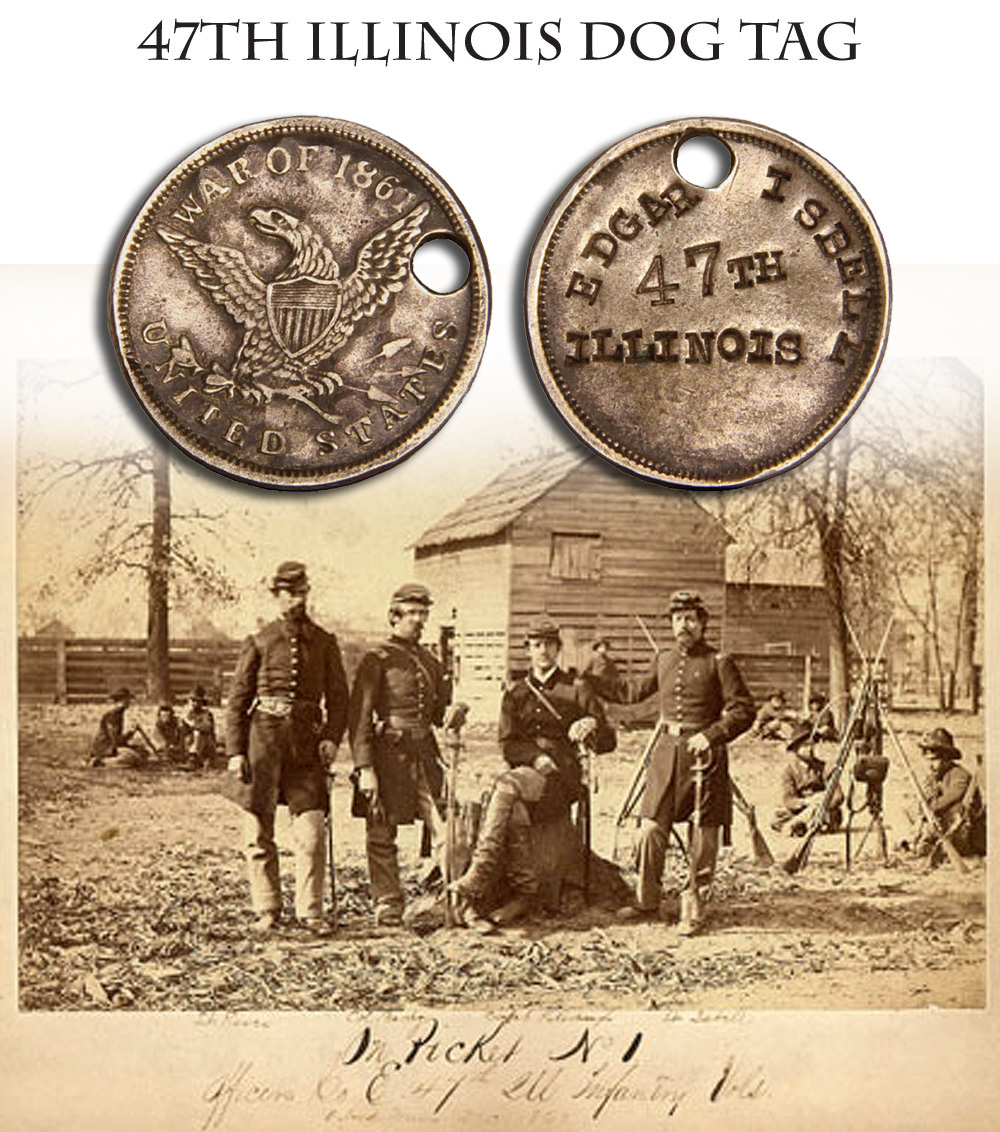
13-09-34 … Western Theatre Civil War Identification Disk:
At the other end of the spectrum from the highly sophisticated inscribed Massachusetts badge above, here is a comparatively simple badge from a mid-western unit. The most exciting aspect to this artifact is that while researching it on the internet I found the camp photo we show above. The owner of this dog tag, Lieutenant Edgar Isbell, is THE officer standing on the right in the above camp scene at Picket Post No 1! The quality of the internet image is not great but when I enlarged the inscription I could in fact read the name Lt. Isbell on the image mount. I was incredulous at first — then darn excited. It is amazing what Google Images has in its archives. I can count the number of western theatre identification disks I have owned over 45 years on two hands. Western troops were so active and so mobile and so seldom in large camps near big cities that it was not very practical for them to find a sutler to supply them with the luxuries so common in the east. It was also not economically feasible for most sutlers in that rural theatre to try to furnish them. The vast majority of ID disks that show up were furnished by sutlers and peddlers to troops camped around Washington, DC, early in 1862. Here is an extremely scarce western example. The disk is a variant of the popular War of 1861 / Eagle style disks that we usually see in brass from eastern units. This one appears to be struck in Brittania or other white metal. The name and unit stamping of individual letters and numbers, are far larger than we see on the eastern examples. This disc is filled out for Edgar Isbell / 47th / Illinois, Shows honest use with a well worn suspension hole. Isbell was from Pekin, Illinois, and enlisted in the 47th on 8/16/61 as First Sergeant in Company E. He was commissioned Second Lieutenant 9/2/62, and served until discharged 11/6/63. The regiment was mustered in at Peoria in August, 1861, and then stationed in St. Louis, MO, at Benton Barracks. During the time he was with it, the regiment served in the Army of the Mississippi and Department of the Tennessee in the 13th, 16th and 15th Corps. They saw action first in Mississippi at Farmington in May, 1862, then later at Iuka, Corinth and Vicksburg. At Corinth they suffered 30 killed and over 100 wounded. They crossed the Mississippi at Grand Gulf and aided in the capture of Jackson, and at Vicksburg they took part in the first charge on the Confederate works, losing 12 men killed, and helped defeat a Confederate force at Mechanicsville, 30 miles outside Vicksburg in June. If I were to guess, I think it most likely Isbell obtained the disk while at Benton Barracks. There was enough commercial activity there from the presence of large groups of soldiers that it is likely an enterprising merchant decided to try his hand at identification disks. This is a darn scarce western variant of the standard eagle device and a very rare example being from a good western unit with real field service. I do not recall ever owning another of these eagle variants. And how often do we find a wartime camp photo showing the owner of one of our artifacts?
One heck of a great personal item …
$795.00
Click Here to E-mail Us!
Call us @ 419-842-1863

13-09-35 – 34 Star Flag …
Measuring approximately 62″ x 65″ … This is a Very Rare and Very Important Southern Sympathizer Union Flag … likely a Vallandingham Democratic Party Copperhead Flag!
Very striking 34-star US flag with wonderful color and complex star pattern- a mix of wreath and spiral pattern with one large central five pointed star and thirty-three others circling and floating around it. Vertical canton extending seven stripes down. The white sixth stripe bearing the inscription in red: “
The Union as our Fathers m[ade it]
” the very right portion of the motto and fly-end of the flag missing, but neatly bordered to preserve it. Minor staining to the white stripes here and there, some small runs along the top and bottom of the third stripe near the fly with minor loss on the bottom edge of the first, all near the fly end. Fabric solid and very displayable.
Northern opponents of Lincoln and government war policy had a big problem: how to oppose it and yet appear loyal. Clement Vallandingham, Democratic Congressman from Ohio became the leader of the faction, termed by opponents “Copperheads,” and was known for his support of states rights and secession, opposition to abolition and equal rights, and votes against every military appropriations bill that came before him. Vallandingham thought he had found a solution to the dilemma of how to proceed in public by blaming abolition for the crisis and claiming to be loyal to the original intent of the Constitution and Union. A good example of Vallandingham’s public tactics was his New York speech of Dec. 12, 1862, reported the next day in the Times,
which incorporated the very motto on this flag
:
“If the Constitution be destroyed the Union perishes with it. [Cries of “Good,” “good,” and applause.] I mean the Union as it was — [applause] —
the Union as our fathers made it
— [applause] — the Union of Washington — of Madison — of John Jay and Alexander Hamilton, [applause,] which gave us peace, prosperity, happiness, grandeur, glory and greatness, such as never belonged to another people since creation’s dawn. [Applause.] The Union, which now is proclaimed to “the Union as it ought to be” -the man who attempts such a Union — a Union different from what descended to us, and all those blessings which our fathers gave us — the man who attempts such a Union, by whatsoever name he may be called, is a traitor. [“Bravo,” and cheers.] Not for any such Union, it is the unity of despotism, not the unity of fraternal affection, or of independent and sovereign States which legislated for themselves. It would be a Union without freedom of the Press, without freedom of speech, without freedom from arrest, without freedom from search — unwarrantable, unreasonable and unconstitutional — without any of the guarantors which a free people have ever demanded; such is the Union which the Abolitionists of this land would set up for the American people, and which they proclaim is the Union as it ought to be. [Applause.] Not such as our fathers made — not such as in 1787 they established and consolidated for the protection and defense of the liberty of the white race of the United States. [Applause.] That Union I am ready to defend.”
Earlier the motto was used by Virginia before she seceded. In February 1861 The Weston (Virginia) Herald editorialized the following in regards to whether Virginia should secede…
“…she (Virginia) will unquestionably take her position with the seceding States. That such a dread alternative may be avoided is the ardent wish and prayer of every patriot in the land. We love and venerate the Union of these States—
the Union as our fathers made it
—the Union with the Constitution—a Union that guarantees equal rights to all the States—a Union whose compromises and whose Constitution will be faithfully and fully carried out by all the parties. “…
Needless to say, the motto “The Union as our Fathers Made It” is unequivocally a pro slavery, pro states rights, sentiment. Vallandingham’s adoption of it in his speech are telling but his efforts did not exactly succeed. He was later arrested for a “habit of declaring sympathies for the enemy” in violation of an order issued in the Military Department of Ohio and eventually expelled to Confederate lines, from where he made his way to Canada and eventually back into the U.S. to run an unsuccessful campaign for Governor of Ohio and take part in McClellan’s 1864 run for the Presidency.
Pro-Union and Pro-Lincoln flags are absolutely common by comparison to those of his northern opponents. There were fewer made to begin with and not many were preserved afterward. Nobody wanted to be reminded they were on the losing side and after the war very few would acknowledge opposition to the martyred President. Whether the last few inches of the fly end of this flag are missing from wear or were intentionally removed to conceal its origin or by a political opponent I can’t say, but it is a striking Stars and Stripes even with that damage and it is a very rare piece of Civil War political history.
… $16,500.00 SOLD
Click Here to E-mail Us!
Call us @ 419-842-1863
Layaways are Welcome
Need to split your order into multiple payments? No problem! A simple 20% earnest money deposit will hold your item for you.-acf
You can then pay it off in easy installments that fit your budget.
Read Terms Here
Items to Sell? Contact Us
I am always interested in buying ANYTHING from the American Civil War… Guns, Swords, Civil War Muskets, Knives, Uniforms, Flags, Medals, Badges, Diaries, Letters, Autographs, Buttons, photographs, tintypes, daguerreotypes, Insignia, Camp Items, Battlefield Relics, canteens, Drums, Etc… Call 419-842-1863 and ask for Dave Taylor.

